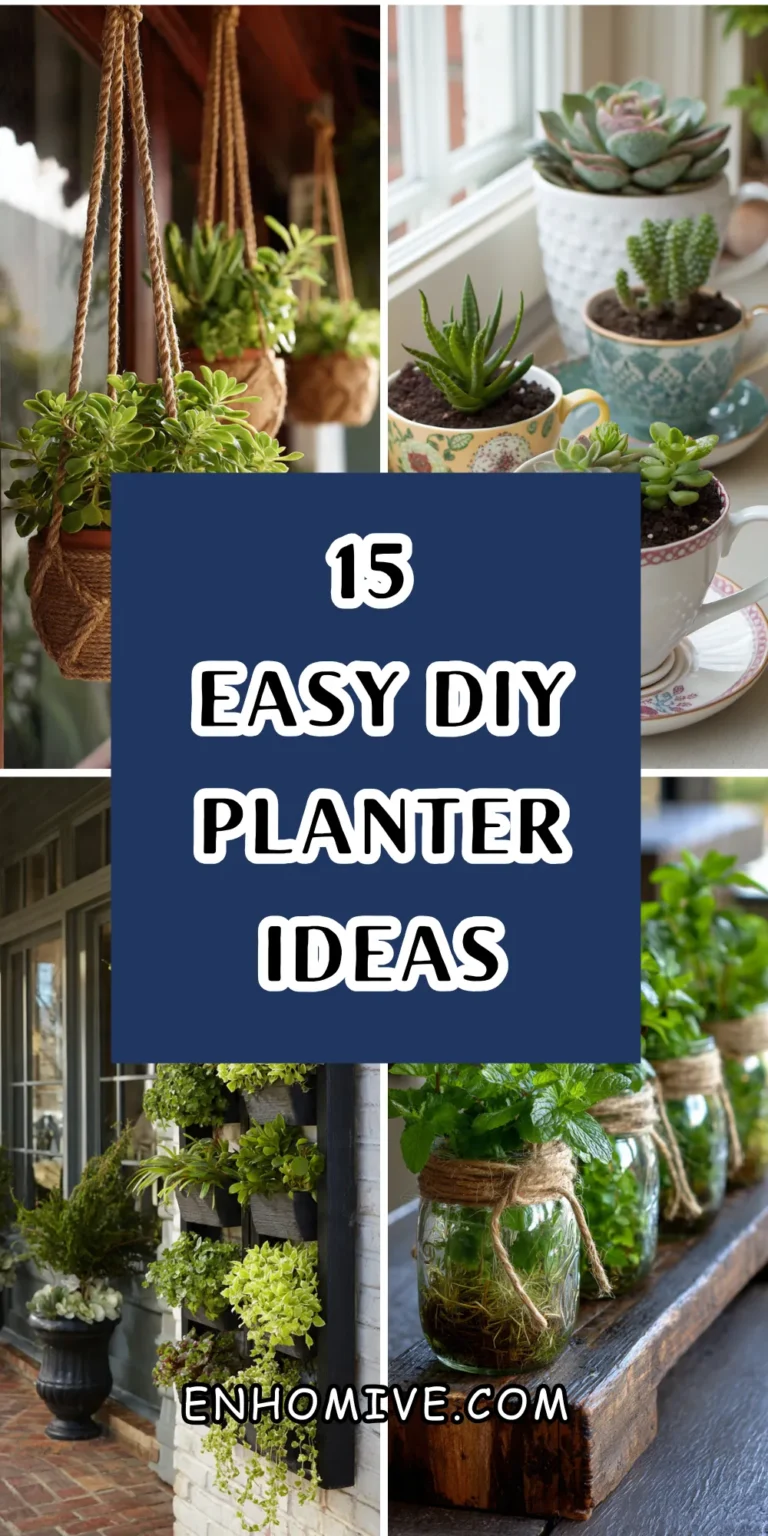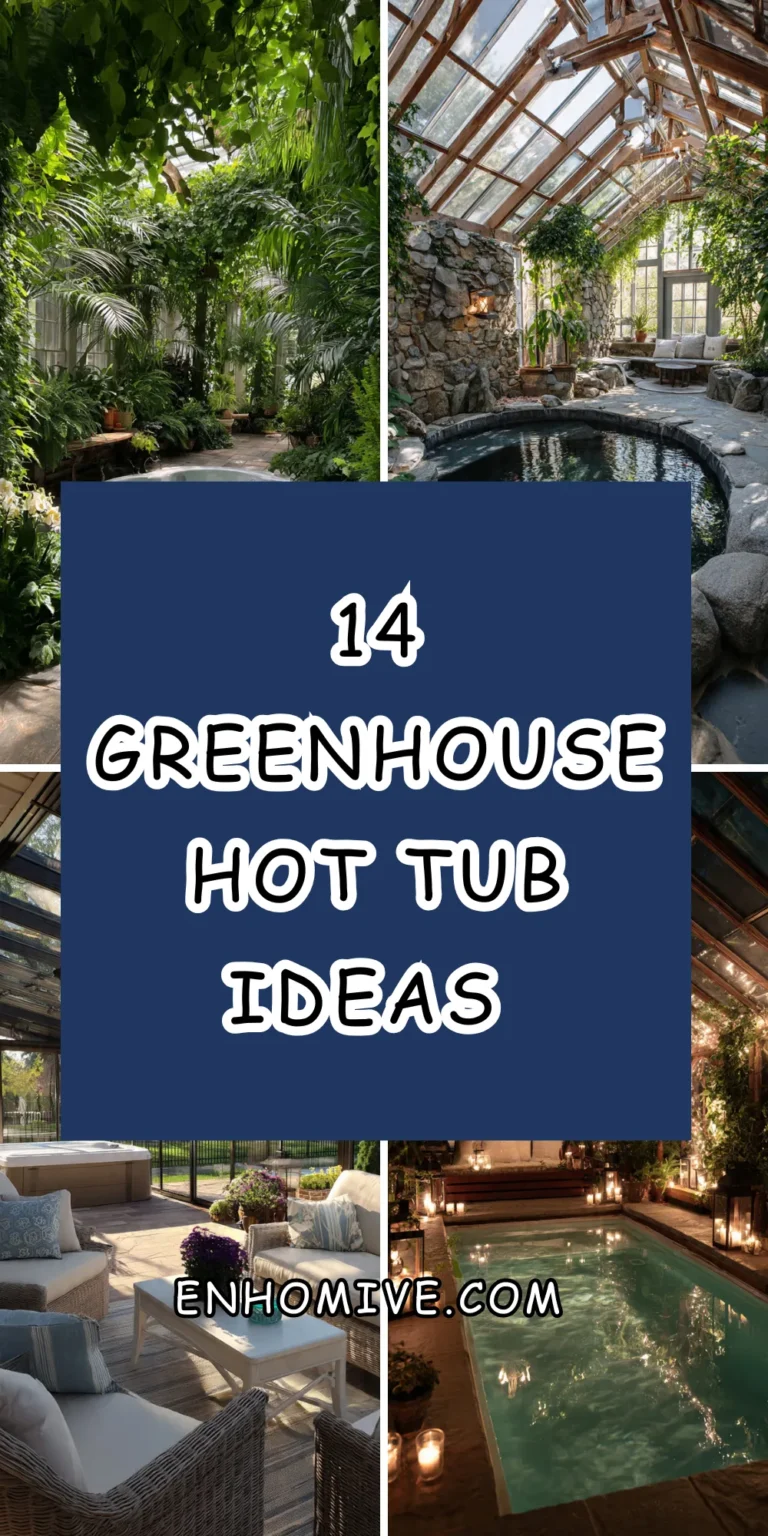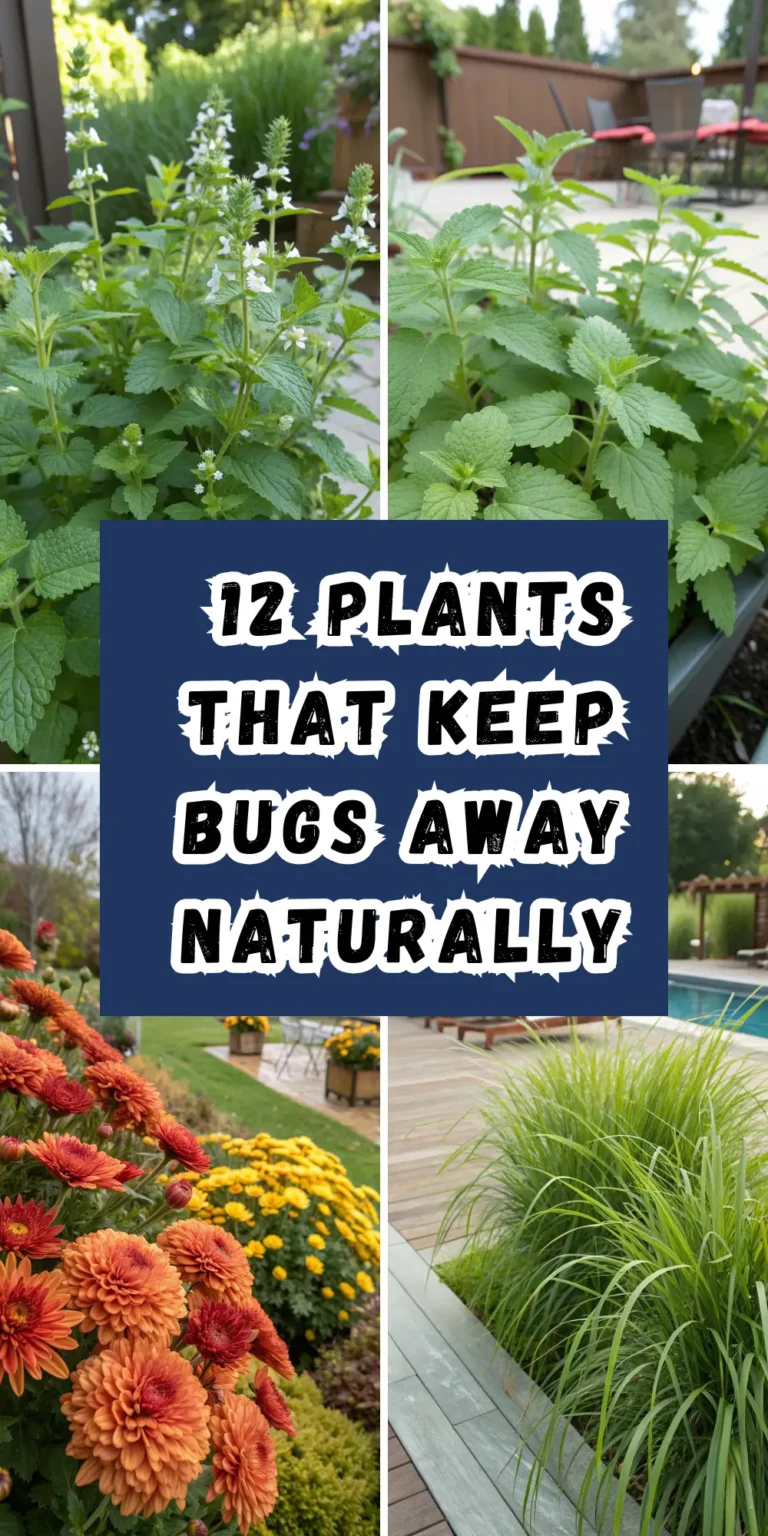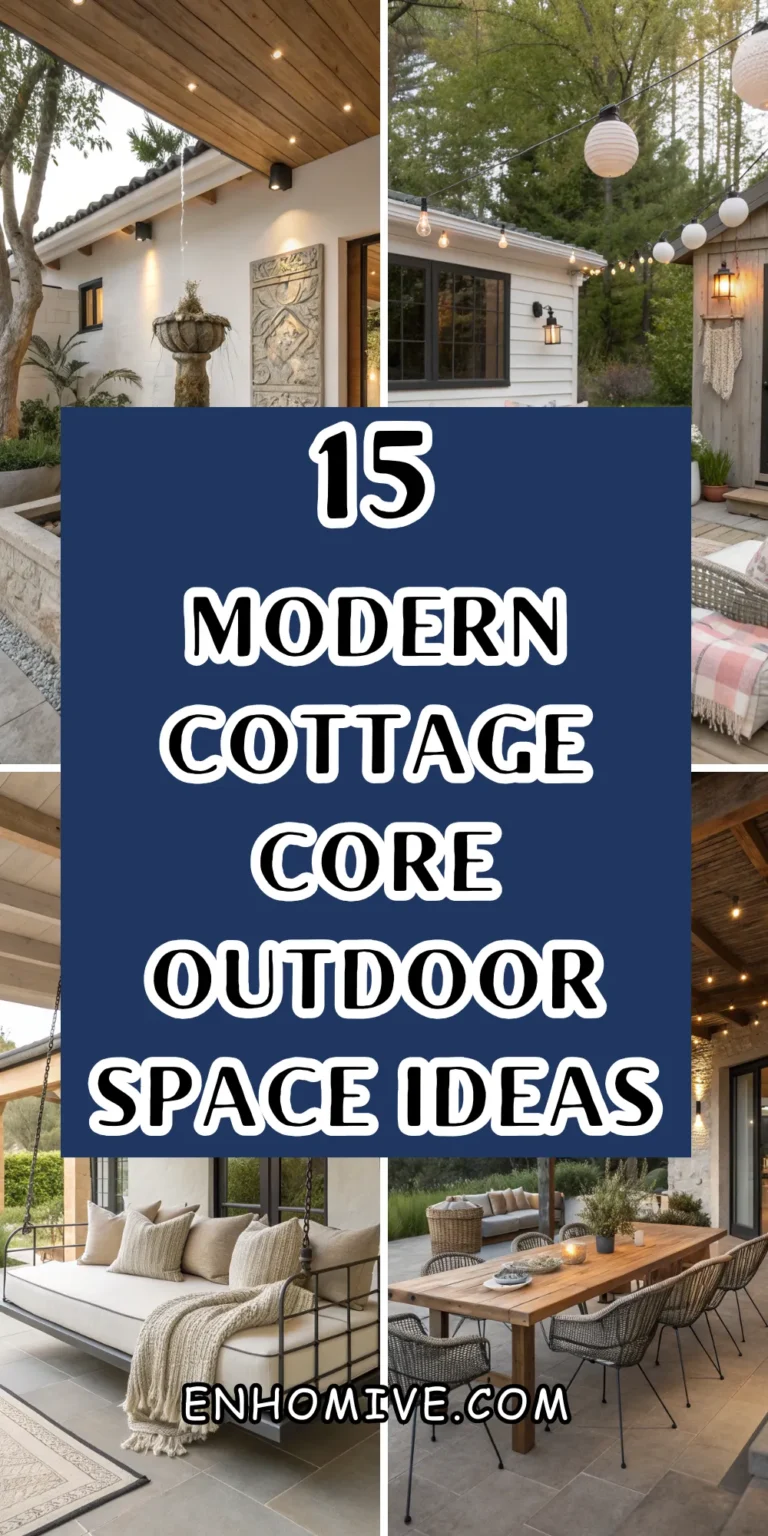17 Front Yard Plant Ideas
Your front yard serves as the welcoming face of your home, creating first impressions that reflect your personal style while enhancing your property’s curb appeal and value. The right combination of plants can transform an ordinary entrance into an inviting landscape that changes beautifully through the seasons while requiring manageable maintenance.

Whether you’re working with a small urban space, a sprawling suburban lot, or something in between, thoughtful plant selection can create visual interest, provide privacy, attract beneficial wildlife, and establish a cohesive design that complements your home’s architecture.
From bold statement trees that anchor the landscape to delicate perennials that add seasonal color, these carefully selected plant ideas will help you create a front yard that not only looks stunning year-round but also thrives in your specific growing conditions while fitting your lifestyle and maintenance preferences.
Japanese Maple Focal Point
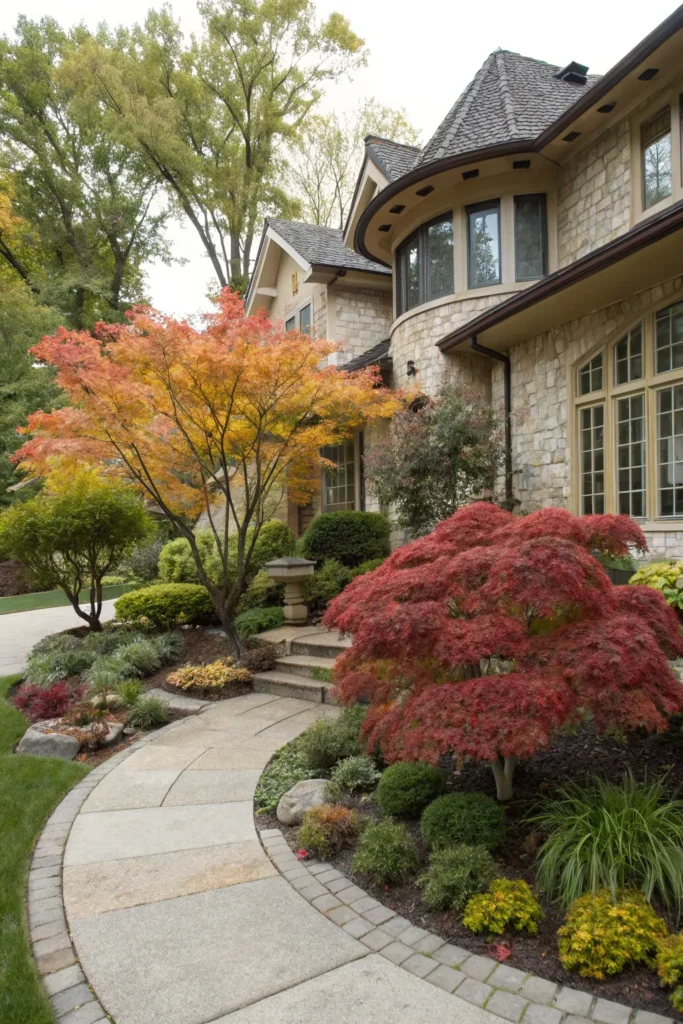
Create a stunning centerpiece using Japanese maples that provide year-round visual interest with their graceful branching structure, delicate foliage, and spectacular seasonal color changes. These elegant trees work beautifully as single specimens or grouped plantings, offering varieties ranging from compact dwarf forms perfect for small spaces to larger specimens that can anchor entire landscape designs.
The diverse range of Japanese maple cultivars allows you to choose specific leaf colors, growth habits, and mature sizes that complement your home’s architecture and existing landscape features. Spring brings fresh green or burgundy foliage, summer offers cooling shade and interesting texture, while fall delivers brilliant oranges, reds, and yellows that create dramatic seasonal displays.
Japanese maples thrive in partially shaded locations with well-drained soil, making them excellent choices for areas near building foundations or under larger tree canopies. Their relatively slow growth rate and compact root systems make them suitable for plantings near walkways, patios, or property lines without concerns about future interference.
Pro Tips:
- Choose varieties appropriate for your climate zone as some cultivars are more cold-hardy than others
- Plant in locations protected from harsh afternoon sun and drying winds for best foliage color
- Apply mulch around the base to maintain consistent soil moisture and protect shallow roots
Lavender Border Planting
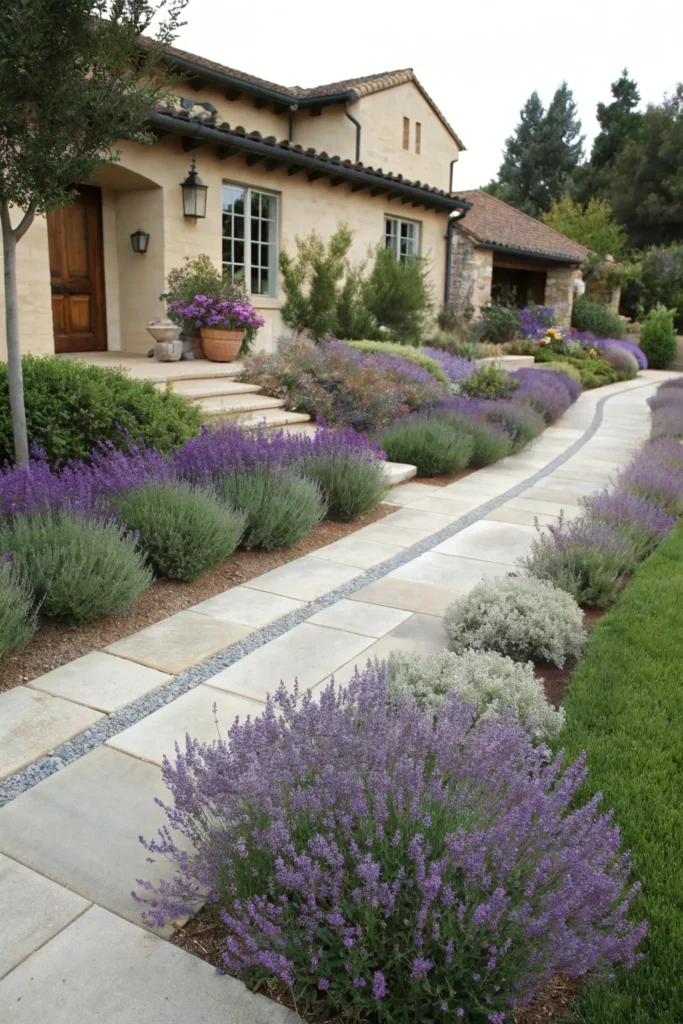
Design aromatic border plantings using lavender varieties that provide drought-tolerant beauty, wonderful fragrance, and beneficial pollinator habitat while creating defined garden edges or pathway borders. Lavender’s silvery foliage and purple flower spikes complement virtually any architectural style while requiring minimal maintenance once established.
Multiple lavender varieties can be combined to extend the blooming season and create subtle color variations, from pale purple to deep violet blooms. The plants’ natural mounding form creates soft, informal borders that work well in both traditional and contemporary landscape designs.
Beyond their ornamental value, lavender plants attract bees, butterflies, and other beneficial insects while their aromatic oils naturally deter many garden pests. The flowers can be harvested for crafts, cooking, or aromatherapy uses, making these plants both beautiful and practical additions to front yard landscapes.
Pro Tips:
- Plant lavender in well-draining soil and full sun locations for best growth and essential oil production
- Prune annually after flowering to maintain compact shape and encourage vigorous blooming
- Space plants appropriately to allow for good air circulation and prevent fungal issues
Evergreen Foundation Planting
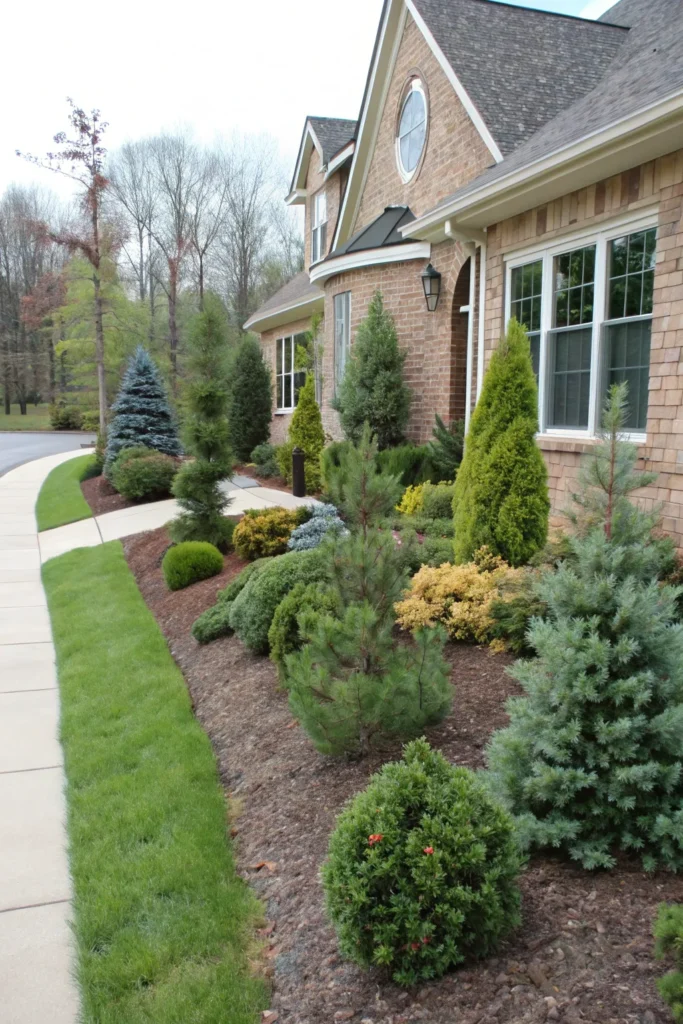
Establish permanent structure using evergreen shrubs and small trees that provide year-round color and form while creating attractive transitions between your home’s architecture and the surrounding landscape. Foundation plantings serve as the backbone of front yard design, providing constant visual anchors that support seasonal plantings and changing garden displays.
Choose evergreens with varying textures, colors, and growth habits to create visual interest while maintaining the cohesive appearance that effective foundation plantings require. Consider mature plant sizes carefully to ensure plantings won’t outgrow their spaces or interfere with windows, walkways, or building maintenance access.
Modern foundation planting designs move beyond traditional formal arrangements to incorporate more naturalistic groupings that complement contemporary architectural styles while still providing the structure and permanence that front yard landscapes require for long-term success.
Pro Tips:
- Research mature plant sizes and growth rates to avoid future overcrowding or maintenance issues
- Select plants appropriate for your specific microclimate conditions including sun exposure and drainage
- Create depth by layering plants of different heights rather than arranging everything in straight lines
Ornamental Grass Collection
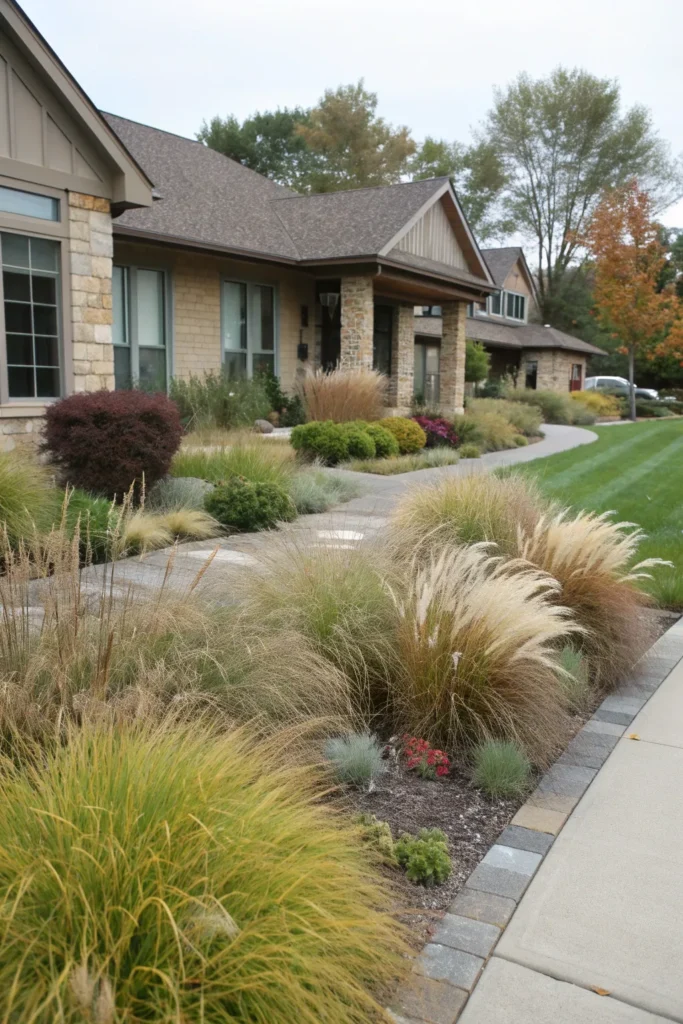
Incorporate ornamental grasses that add movement, texture, and seasonal interest while providing low-maintenance beauty that works well with both traditional and contemporary landscape styles. Grasses offer unique design elements that change throughout the growing season, from fresh spring growth to dramatic winter seed heads.
Different grass varieties provide various design opportunities, from compact border plants to large specimen clumps that can serve as focal points or privacy screens. The natural movement of grasses in breezes adds dynamic elements to static landscape designs while their varied textures create interesting contrasts with broadleaf plants.
Many ornamental grasses are extremely drought-tolerant once established, making them excellent choices for challenging growing conditions or low-maintenance landscape designs. Their extended seasonal interest means they contribute to garden beauty even during dormant months when many other plants are less attractive.
Pro Tips:
- Choose clumping varieties rather than spreading types to maintain control over plant placement and size
- Cut back grasses in late winter or early spring before new growth begins for tidiest appearance
- Group grasses with similar water and sun requirements for easier maintenance and better plant health
Colorful Annual Display
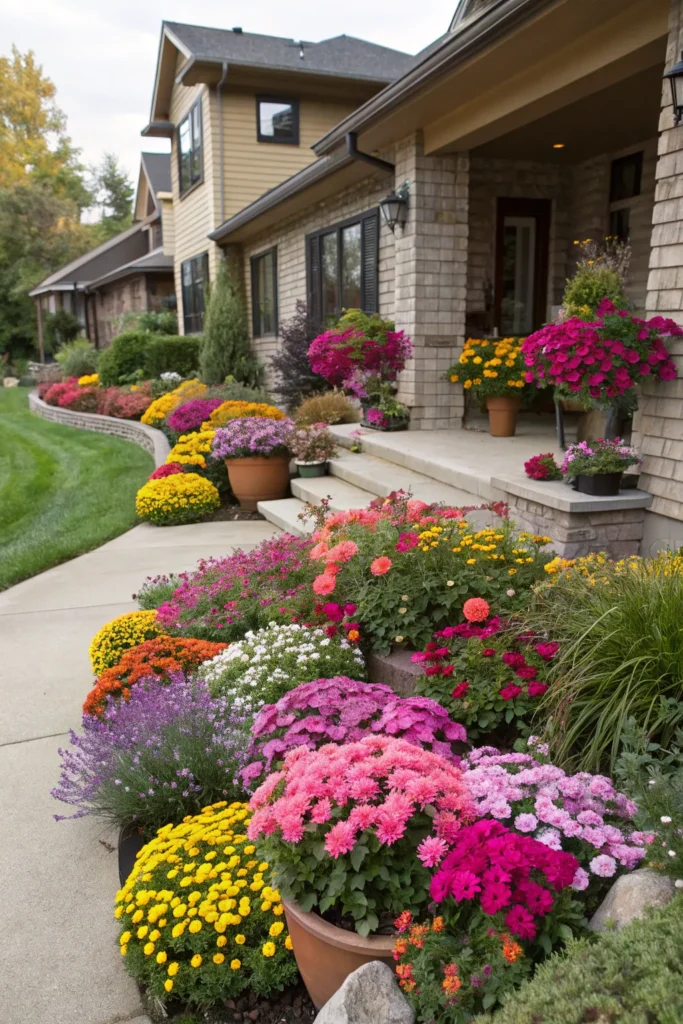
Design vibrant seasonal displays using annual flowers that provide continuous color from spring through fall while allowing you to change color schemes and plant combinations each growing season. Annual plantings offer unlimited creative possibilities and can be adjusted each year to reflect changing preferences or garden conditions.
Strategic placement of annual displays can highlight architectural features, create focal points, or provide seasonal color in areas where permanent plantings might be impractical. Container plantings allow for even more flexibility, enabling you to move color displays to different locations as needed.
The temporary nature of annual plantings means you can experiment with bold color combinations, unusual plant varieties, or trending garden styles without making permanent commitments. This flexibility also allows you to adapt plantings based on seasonal celebrations, personal preferences, or changing garden conditions.
Pro Tips:
- Choose annuals appropriate for your local growing season length and climate conditions
- Plan succession plantings to maintain continuous color throughout the growing season
- Incorporate plants with different bloom times to extend the display period and visual interest
Native Plant Garden
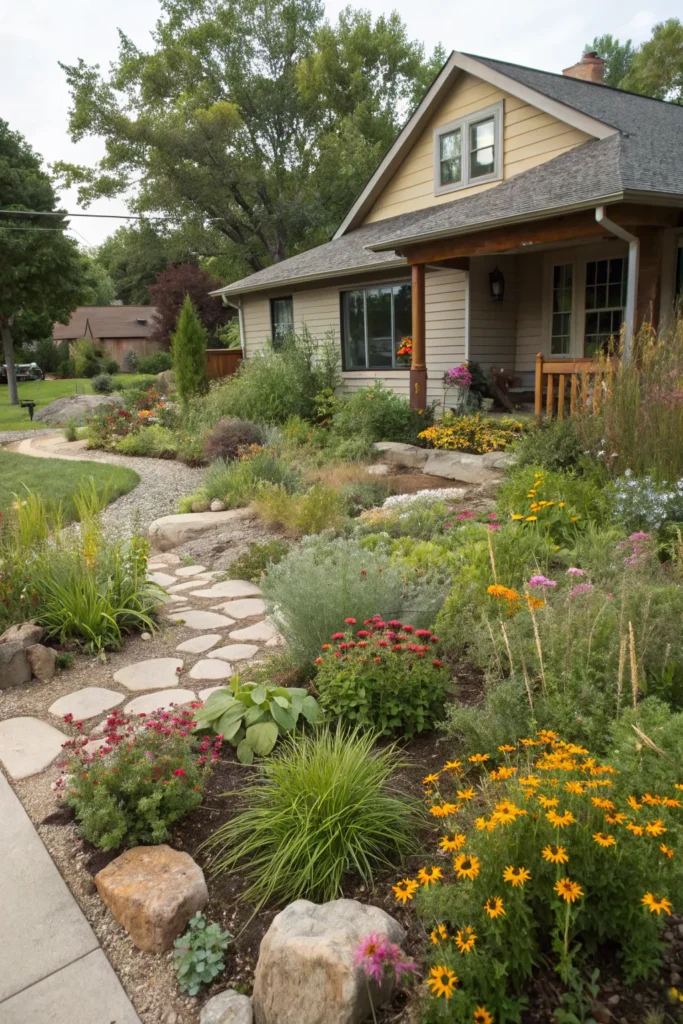
Create sustainable, low-maintenance landscapes using plants native to your region that provide authentic local character while supporting native wildlife and requiring minimal supplemental watering or fertilization. Native plant gardens celebrate regional botanical heritage while providing practical benefits for both gardeners and local ecosystems.
Native plants are naturally adapted to local soil conditions, rainfall patterns, and temperature fluctuations, making them more resilient and less demanding than exotic alternatives. They provide essential habitat and food sources for native birds, butterflies, and other wildlife that have co-evolved with these plants over thousands of years.
Beyond their ecological benefits, native plants offer unique beauty that reflects the natural character of your region. Many native species provide interesting seasonal changes, attractive flowers, colorful fruits, or striking foliage that creates distinctive landscape character while celebrating local botanical heritage.
Pro Tips:
- Research plants native specifically to your local region rather than just your general geographic area
- Start with easier native species and gradually add more challenging varieties as you gain experience
- Connect with local native plant societies or extension services for specific growing advice and plant sources
Rose Garden Entrance
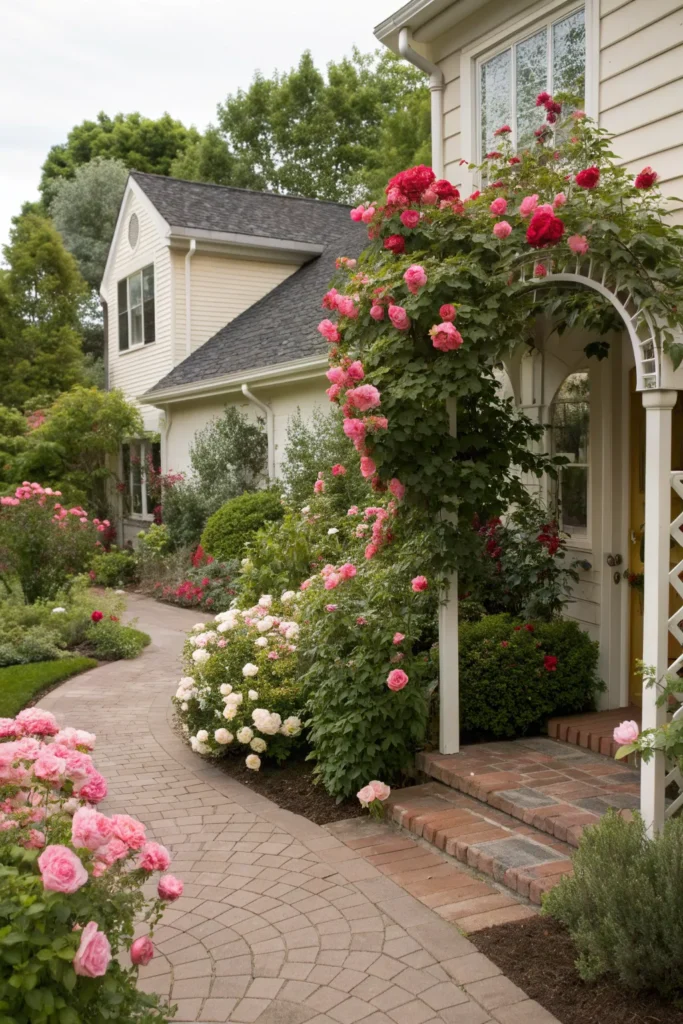
Design welcoming entrance gardens using roses that provide classic beauty, wonderful fragrance, and seasonal interest while creating romantic, traditional landscape character. Modern rose varieties offer improved disease resistance and extended blooming periods that make them more practical for busy homeowners while maintaining the timeless appeal roses bring to landscape designs.
Different rose types can be combined to create layered displays with varying heights, colors, and blooming characteristics. Shrub roses provide informal structure, climbing varieties can enhance architectural features, and compact varieties work well in containers or border plantings.
Proper rose selection for your climate and growing conditions ensures healthy plants that bloom prolifically with reasonable maintenance requirements. Modern roses often combine the beauty of traditional varieties with improved resistance to common diseases and pests.
Pro Tips:
- Choose disease-resistant varieties appropriate for your local climate conditions and soil type
- Plan for adequate air circulation between plants to prevent fungal diseases
- Include companion plants that complement roses while providing extended seasonal interest
Shade Garden Sanctuary
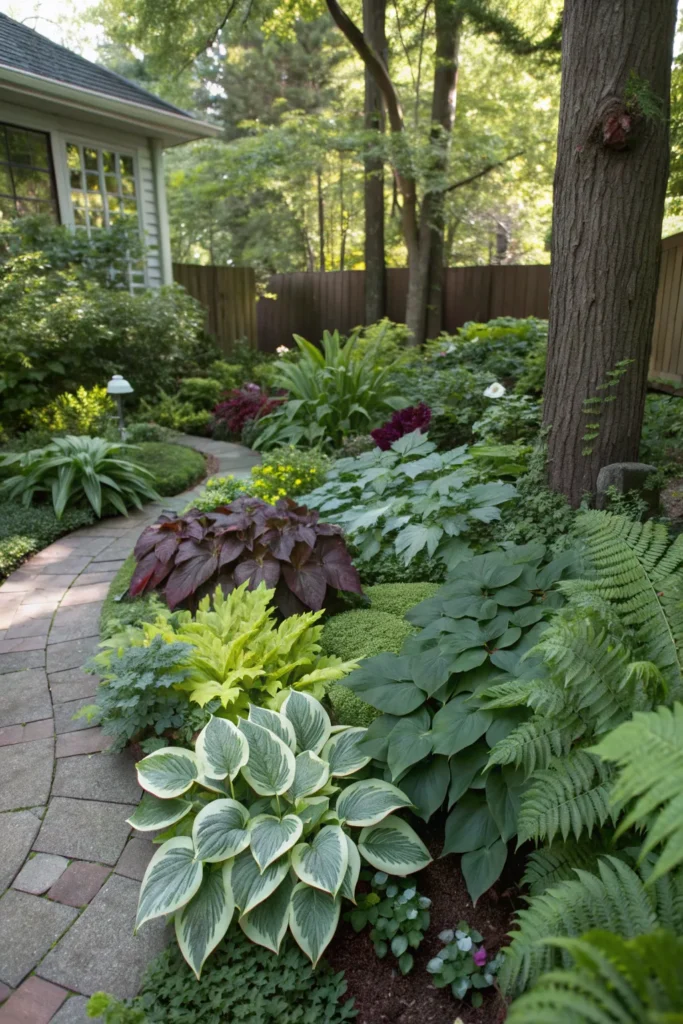
Transform challenging shaded areas using plants that thrive in lower light conditions while creating lush, peaceful garden spaces that provide cool retreats and interesting foliage combinations. Shade gardens offer opportunities to explore plants with unique leaf shapes, colors, and textures that might be overwhelmed in sunny locations.
Successful shade gardens rely heavily on foliage plants that provide year-round interest through varied leaf colors, textures, and forms. Hostas, ferns, heucheras, and other shade perennials can create rich tapestries of green, silver, burgundy, and yellow that change subtly throughout the growing season.
Many shade plants produce delicate flowers that add seasonal color without requiring the intense sunlight that many flowering plants demand. These subtle blooms often have unique characteristics that reward close observation and create intimate garden experiences.
Pro Tips:
- Assess your shade conditions carefully as different plants require different levels of shade intensity
- Focus on foliage plants for reliable season-long interest rather than depending primarily on flowers
- Improve soil with organic matter to help plants thrive in the challenging conditions shade often creates
Succulent Rock Garden

Create drought-tolerant landscapes using succulent plants combined with decorative rocks and gravel that provide unique textures, interesting forms, and minimal maintenance requirements. Succulent gardens work particularly well in areas with challenging growing conditions or where water conservation is important.
The incredible diversity of succulent plants allows for creative combinations that showcase different colors, shapes, and sizes while maintaining the unified appearance that effective landscape design requires. From tiny ground-covering sedums to large architectural agaves, succulents offer options for every garden size and style preference.
Rock gardens provide excellent drainage that succulents require while creating attractive settings that complement these plants’ unique characteristics. The combination of living plants and decorative stones creates year-round interest that doesn’t depend on seasonal flowers or foliage changes.
Pro Tips:
- Ensure excellent drainage by amending soil with coarse sand or gravel before planting
- Choose succulents appropriate for your winter hardiness zone as cold tolerance varies significantly
- Group plants with similar water requirements to simplify maintenance and ensure plant health
Flowering Shrub Collection
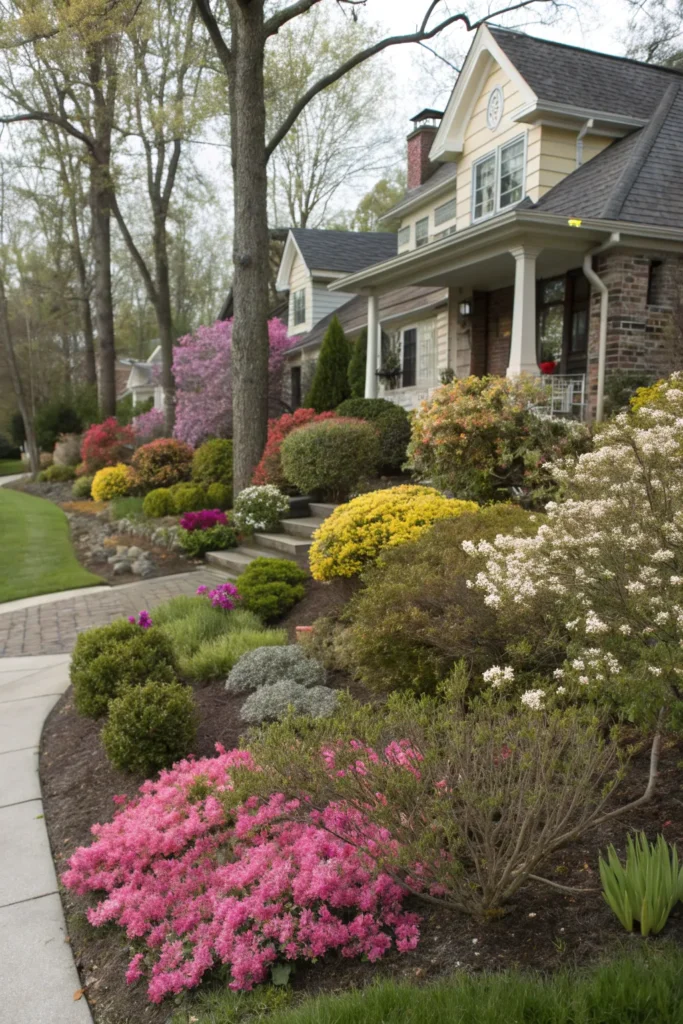
Develop seasonal interest using flowering shrubs that provide structure, privacy, and spectacular bloom displays while creating permanent landscape elements that improve with age. Flowering shrubs offer excellent value by combining the permanence of trees with the colorful displays of perennial flowers.
Different shrub varieties can be selected to provide blooms throughout the growing season, from early spring bulb companions to late summer and fall-blooming varieties that extend garden interest well beyond traditional flower garden seasons. Many flowering shrubs also provide attractive foliage, interesting bark, or colorful fruits that contribute to multi-season appeal.
Strategic placement of flowering shrubs can create privacy screens, define outdoor spaces, or serve as transition elements between different garden areas. Their permanent nature makes them excellent investments that increase in beauty and value as they mature.
Pro Tips:
- Research mature sizes carefully to ensure shrubs won’t outgrow their intended locations
- Choose varieties that bloom at different times to extend the season of flower display
- Consider plants that provide multiple seasons of interest beyond just their flowering period
Herb Garden Display
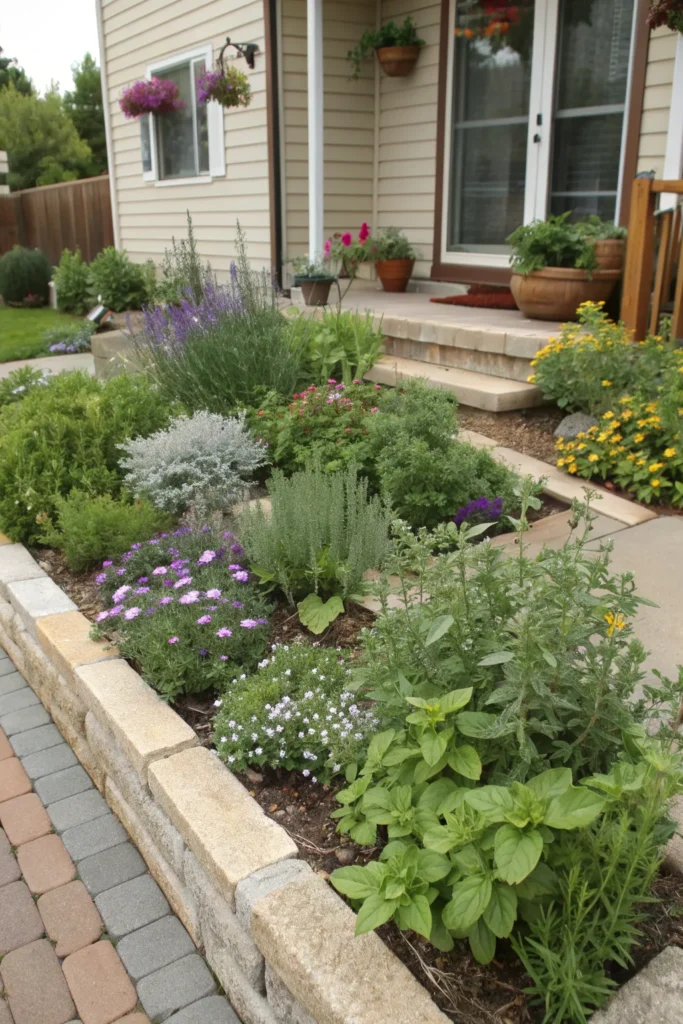
Combine culinary and ornamental benefits using herb plants that provide fresh ingredients for cooking while creating attractive, fragrant garden displays that engage multiple senses. Herb gardens offer practical benefits that make them particularly satisfying for gardeners who enjoy combining beauty with utility.
Many herbs produce attractive flowers that can be just as ornamental as traditional flowering plants while also attracting beneficial pollinators to the garden. The varied textures and colors of herb foliage create interesting design opportunities that work well in both formal and informal garden styles.
Positioning herb gardens near entrances or windows allows you to enjoy their fragrances daily while making fresh herbs easily accessible for cooking. The aromatic qualities of many herbs also provide natural pest deterrent benefits for nearby plants.
Pro Tips:
- Group herbs with similar water and sun requirements for easier maintenance and better plant health
- Include both annual and perennial herbs to provide immediate use and long-term garden structure
- Harvest herbs regularly to encourage continued growth and prevent plants from becoming woody
Bulb Naturalization Area

Create spectacular spring displays using bulbs planted in naturalistic drifts that provide early season color when most other plants are still dormant. Naturalized bulb plantings can transform ordinary lawn areas into seasonal flower meadows that return year after year with minimal maintenance.
Different bulb varieties can be combined to extend the blooming season from late winter through late spring, providing months of changing color displays. Early bulbs like crocuses and snowdrops can be followed by daffodils, tulips, and alliums for continuous seasonal interest.
Naturalized bulb areas work particularly well under deciduous trees where spring sun reaches the ground before trees leaf out, but summer shade protects bulb foliage as it dies back naturally. This combination creates ideal growing conditions while making use of areas that might be challenging for other plants.
Pro Tips:
- Plant bulbs in irregular, natural-looking drifts rather than formal rows or geometric patterns
- Allow bulb foliage to die back naturally to ensure energy storage for next year’s blooms
- Choose bulb varieties that naturalize well in your climate and will return reliably year after year
Vertical Garden Elements
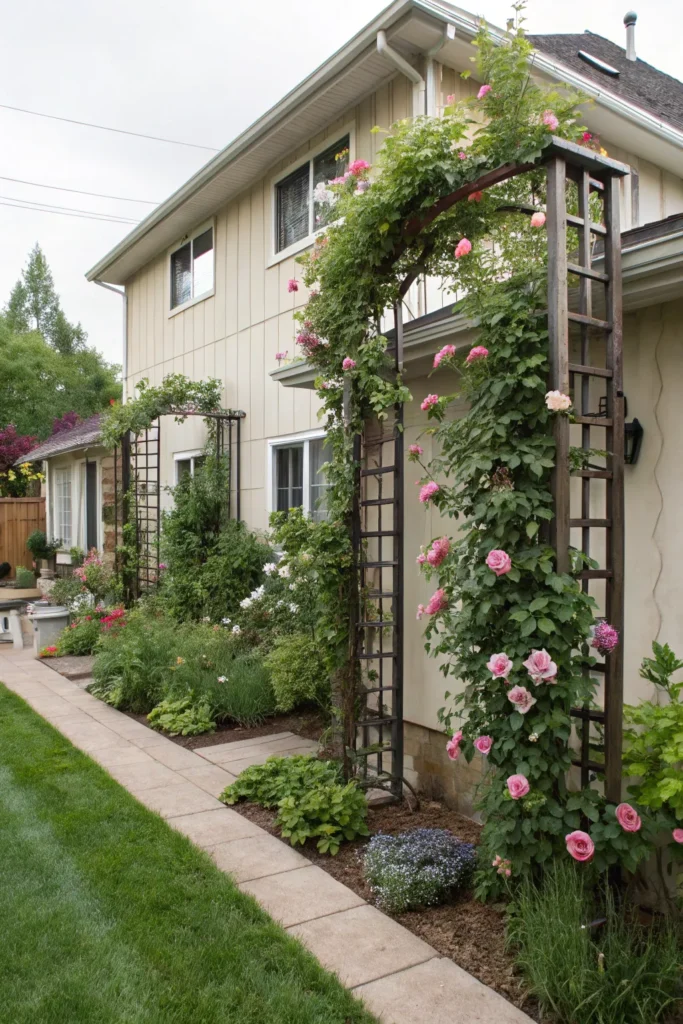
Maximize planting space and create privacy using climbing plants, trellises, and vertical growing systems that add height and structure to front yard landscapes while making efficient use of limited space. Vertical elements can transform flat landscapes into dynamic, multi-dimensional garden experiences.
Climbing roses, clematis, ivy, and other vertical plants can soften harsh architectural lines while providing seasonal color, fragrance, and wildlife habitat. Support structures become garden features themselves when chosen thoughtfully to complement your home’s style and landscape design goals.
Vertical plantings can provide privacy screening, hide unsightly features, or create focal points that draw attention upward and make small spaces feel larger. The additional growing space that vertical elements provide is particularly valuable in urban settings or small front yards.
Pro Tips:
- Choose support structures sturdy enough to handle mature plant weight and wind loads
- Consider maintenance access when positioning trellises and climbing plants near buildings
- Select climbing plants appropriate for your local climate and the specific exposure of vertical growing areas
Seasonal Color Rotation
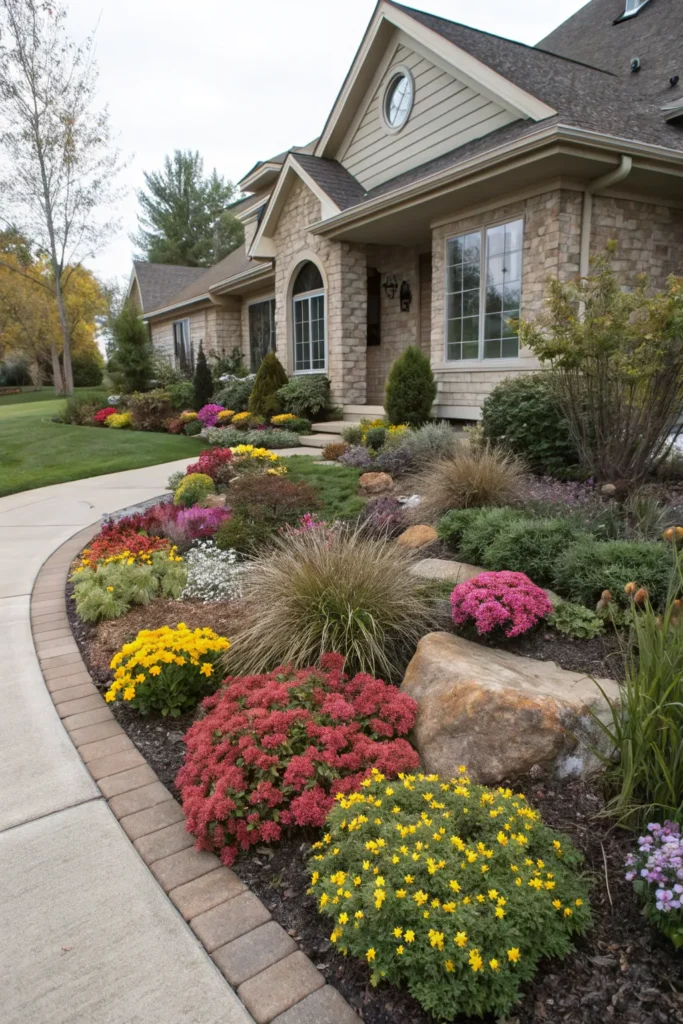
Plan continuous seasonal interest using a combination of plants that provide changing displays throughout the year, ensuring your front yard remains attractive during all seasons rather than just peak growing periods. This approach requires careful plant selection and timing but rewards you with year-round garden beauty.
Spring bulbs can be followed by early perennials, summer annuals, fall-blooming asters and mums, and winter interest plants like ornamental grasses or evergreen shrubs with colorful berries. Each season brings new highlights while maintaining overall garden structure and appeal.
Successful seasonal rotation requires understanding your local growing conditions and bloom times while planning plant combinations that complement each other and provide smooth transitions between seasonal displays. Container plantings can supplement in-ground plants to fill seasonal gaps or add flexibility to color schemes.
Pro Tips:
- Keep detailed records of bloom times and plant performance to improve future seasonal planning
- Include plants with interesting winter characteristics like colorful bark, persistent fruits, or attractive seed heads
- Use evergreen plants as permanent anchors that provide structure during transitional periods
Pollinator-Friendly Border
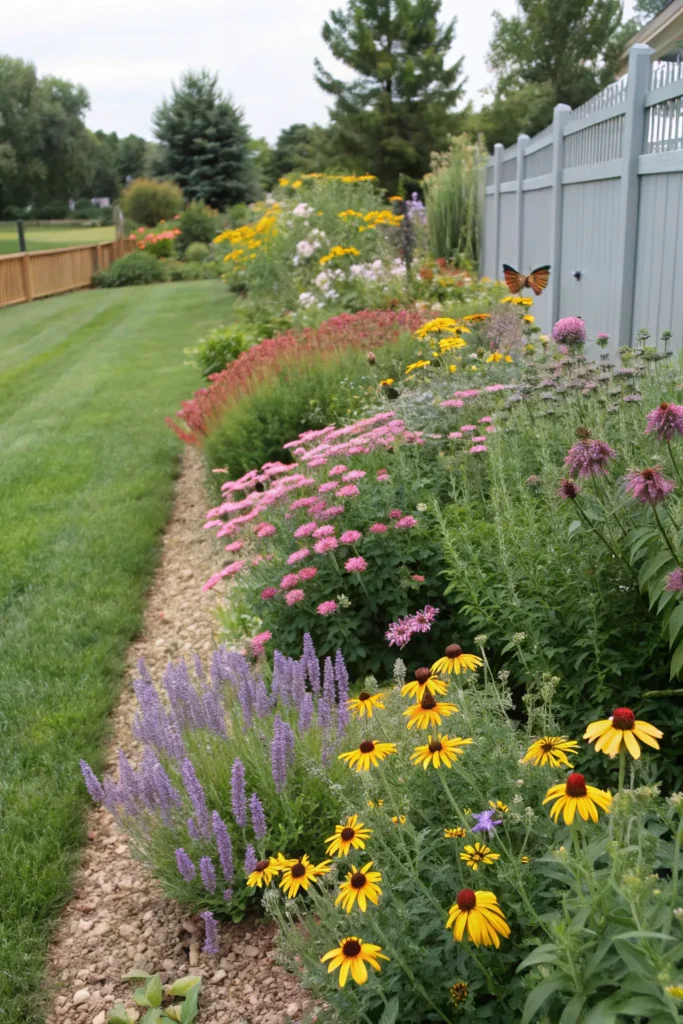
Design environmentally beneficial landscapes using plants that provide nectar, pollen, and habitat for bees, butterflies, and other beneficial insects while creating colorful, dynamic garden displays that change throughout the growing season. Pollinator gardens contribute to environmental health while providing exceptional beauty and interest.
Native wildflowers, herbs, and flowering shrubs can be combined to provide continuous blooming throughout the growing season, ensuring consistent food sources for various pollinator species. Different flower shapes and colors attract different beneficial insects, creating diverse and active garden ecosystems.
Pollinator-friendly gardens require minimal chemical inputs and often thrive with naturalistic maintenance approaches that benefit both plants and wildlife. The active presence of butterflies, bees, and birds adds movement and life to garden spaces while contributing to broader environmental health.
Pro Tips:
- Include plants with different flower shapes and blooming times to support various pollinator species
- Avoid using pesticides that can harm beneficial insects even when targeting pest species
- Provide water sources and nesting habitat in addition to flowering plants for complete pollinator support
Architectural Plant Accents
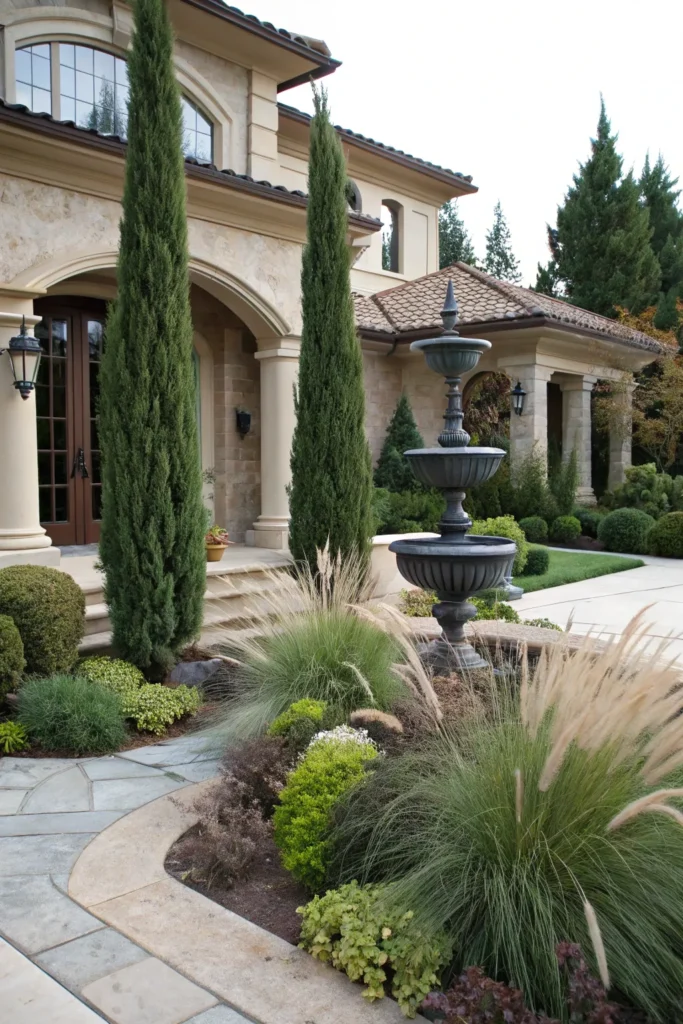
Enhance your home’s architecture using plants with strong structural qualities that complement building lines, emphasize entrance features, or create striking focal points that integrate landscape and architecture seamlessly. Architectural plants serve as living design elements that bridge the gap between natural and built environments.
Plants with distinctive forms like columnar evergreens, fountain-shaped grasses, or plants with bold foliage can echo or contrast with architectural features to create cohesive design relationships. The key is selecting plants whose natural characteristics complement rather than compete with your home’s style and proportions.
Strategic placement of architectural plants can emphasize entrance doors, frame windows, or create dramatic shadows that add depth and interest to building facades. These plants often serve as year-round features that maintain their impact regardless of seasonal changes in other garden areas.
Pro Tips:
- Consider how plant shadows will affect both building appearance and interior lighting throughout the day
- Choose plants whose mature size will remain proportionate to architectural features they’re meant to complement
- Use repetition of architectural plants to create rhythm and unity in landscape design
Mixed Container Garden
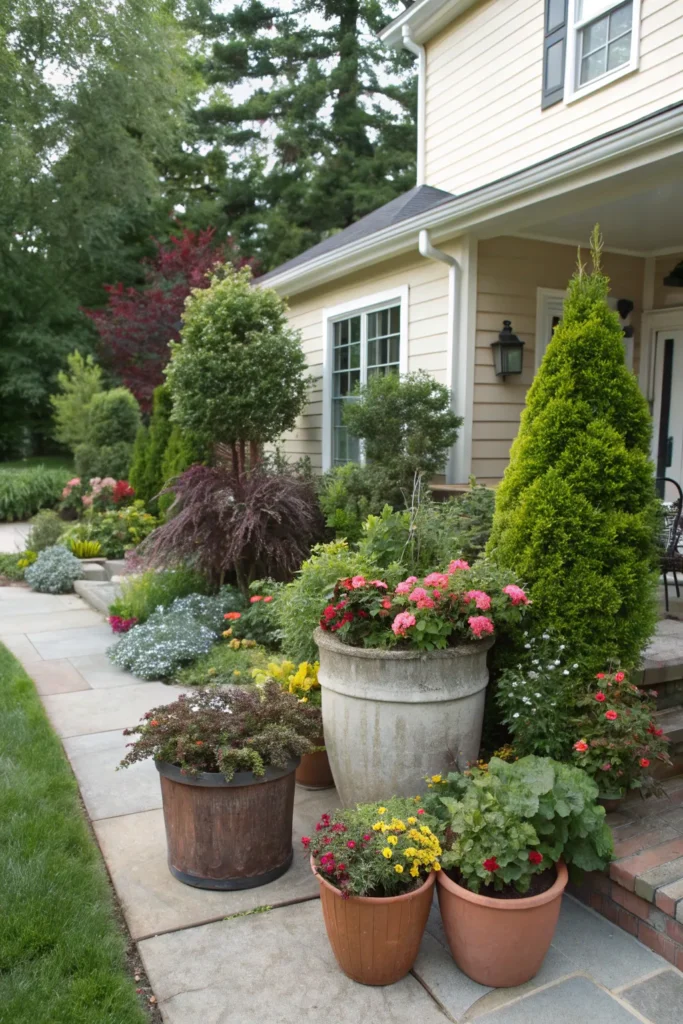
Create flexible, high-impact displays using container plantings that allow you to experiment with plant combinations, adapt to changing conditions, and move seasonal displays to optimize visual impact throughout your front yard space. Container gardens provide maximum design flexibility while minimizing long-term commitments and permanent landscape changes.
Large containers can house small trees or substantial shrub plantings that create immediate impact and can be repositioned as needs change or seasons progress. Groupings of smaller containers allow for complex plant combinations and seasonal rotation while maintaining manageable weight and maintenance requirements.
Container gardening enables you to grow plants that might not thrive in your native soil conditions while providing opportunities to experiment with new varieties, color combinations, or design styles before committing to permanent plantings. The mobility of containers also allows for seasonal storage or protection during extreme weather conditions.
Pro Tips:
- Choose containers large enough to accommodate mature plant root systems and minimize watering frequency
- Use high-quality potting soil rather than garden soil for better drainage and plant health in containers
- Group containers of different sizes and heights to create natural-looking displays with varied visual interest
Creating a beautiful front yard landscape is an investment in both your daily enjoyment and your property’s long-term value, but success depends on choosing plants that match your local growing conditions, maintenance preferences, and design goals.
The most effective front yard plantings combine immediate visual impact with long-term sustainability, creating landscapes that improve with age while requiring manageable maintenance commitments. Remember that great landscapes develop over time, so start with a solid foundation of structural plants and gradually add seasonal elements and refinements as your garden matures and your understanding of your specific growing conditions deepens.
Whether you prefer low-maintenance native plants, colorful seasonal displays, or sophisticated architectural plantings, the key is selecting plants that will thrive in your specific location while creating the welcoming, attractive entrance that reflects your personal style and enhances your home’s unique character.


